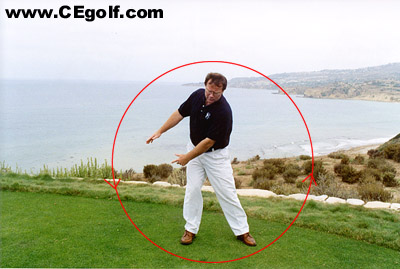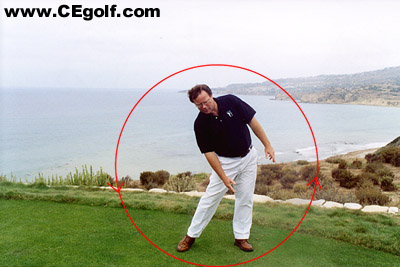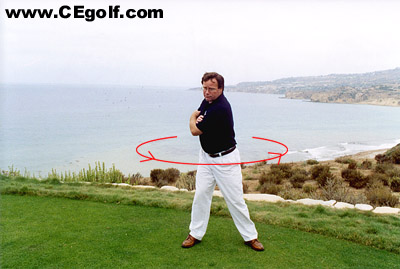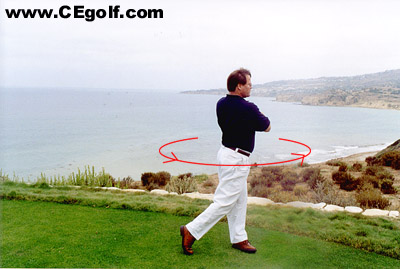
The Upright Swing
And The Block
All pictures were taken at Ocean Trails Golf Club, which is now Trump National Golf Club Los Angeles, in Rancho Palos Verdes, California.
Before I start, I want to mention that I discuss how good golfers avoid the steep downswing on The Steep Downswing page.
The most common thing beginners do when they try to hit a golf ball for the first time is lift the club up high into the air with the arms and then pull steeply back down to the ground. The typical result of this type of swinging motion is a slice, and since most golfers refine this steep arm swing over time it is no wonder most golfers slice.
When the arms swing forward in this steep swing plane, the body tends to slide sideways and the arms pull across the body toward the target. This causes the clubhead to drag through the impact area with an open clubface. Surprisingly, a hook can also be the result of this dragging tendency, but it's an over correction—closing the club too much or too early in an effort to avoid hitting the ball right (for right handers).
You've probably heard of the term "block", well this tendency to drag the clubface through impact is it. You generally won't see a true block because golfers who block make corrective motions, called manipulations, to counter the open clubface. The block is part of just about every steep swing, but as I mentioned at the beginning, good golfers don't swing forward as steeply as most amateurs and this minimizes the block. Less block means less manipulation, and that means less dependency on timing.
Manipulations can be arm, wrist, or body movements that can occur at address—a strong grip (anything stronger than neutral); during the backswing—a closed clubface; or during the forward swing—casting and coming over-the-top, flipping (throwing the clubhead into the ball with the hands), and rolling the arms over, to list a few. Because all manipulations are an attempt to counteract the block, they are all movements that try to close the clubface in order for it to get square (pointing at the target) by the time it reaches the ball.


The first two pictures show the incorrect body motion that is connected with the block.

As an alternative for those who struggle to make the steep swing work, the last two pictures show how the body can move so it can synchronize with the arms and club, while at the same time create speed and maintain control. It's simple, the body winds and unwinds (also referred to as coil and uncoil). For the body to move this way, the arms should swing more with the rotating body (more around), especially in the forward swing.

If you're having trouble with the navigaton bar (left), try the CEGolf.com Contents page.
Casey Eberting Golf Instruction
©Copyright 1997-2024, All Rights Reserved